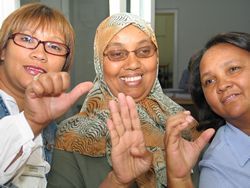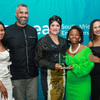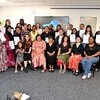Speak to the hand
07 March 2007 | Story by Helen Swingler
"Right hand only, elbow away from the table," Emma Coop instructs as we start the sign language alphabet.
We're at letter f. Three fingers up - "No, not those three, the first three," Coop corrects - index finger and thumb together, palm towards the other person. Her face is unusually expressive, part of the communication arsenal used to augment "signing".
Hand shapes, body and arm orientation and movement, facial expressions, all convey meaning.
"People who use sign language as a primary means of communicating are known as Deaf. Capital D denotes that they use sign language and are part of the Deaf Community," Coop adds.
Hard of hearing and "passionate about signing", one of her tasks is running the Disability Service's Resource Centre.
"The aim is to integrate more Deaf and Hearing Impaired students on campus - and the more students and staff who can use sign language the better."
For donations officer and linguaphile Abiedah Abrahams, signing adds to her language store. She's also learning Arabic (through a local Walmer Estate school on Saturday mornings) and Xhosa (at UCT, lunchtimes).
"It all just stretches your horizons."
There are sign language classes in the Disability Service Resource Centre, Steve Biko Student Union, on Monday, 10h00 to 10h30, or Tuesday, 13h00 to 13h30. Classes on the [health sciences] campus are in Seminar Room 1, Falmouth Building, on Monday or Wednesday between 12h00 and 12h30.
 This work is licensed under a Creative Commons Attribution-NoDerivatives 4.0 International License.
This work is licensed under a Creative Commons Attribution-NoDerivatives 4.0 International License.
Please view the republishing articles page for more information.










